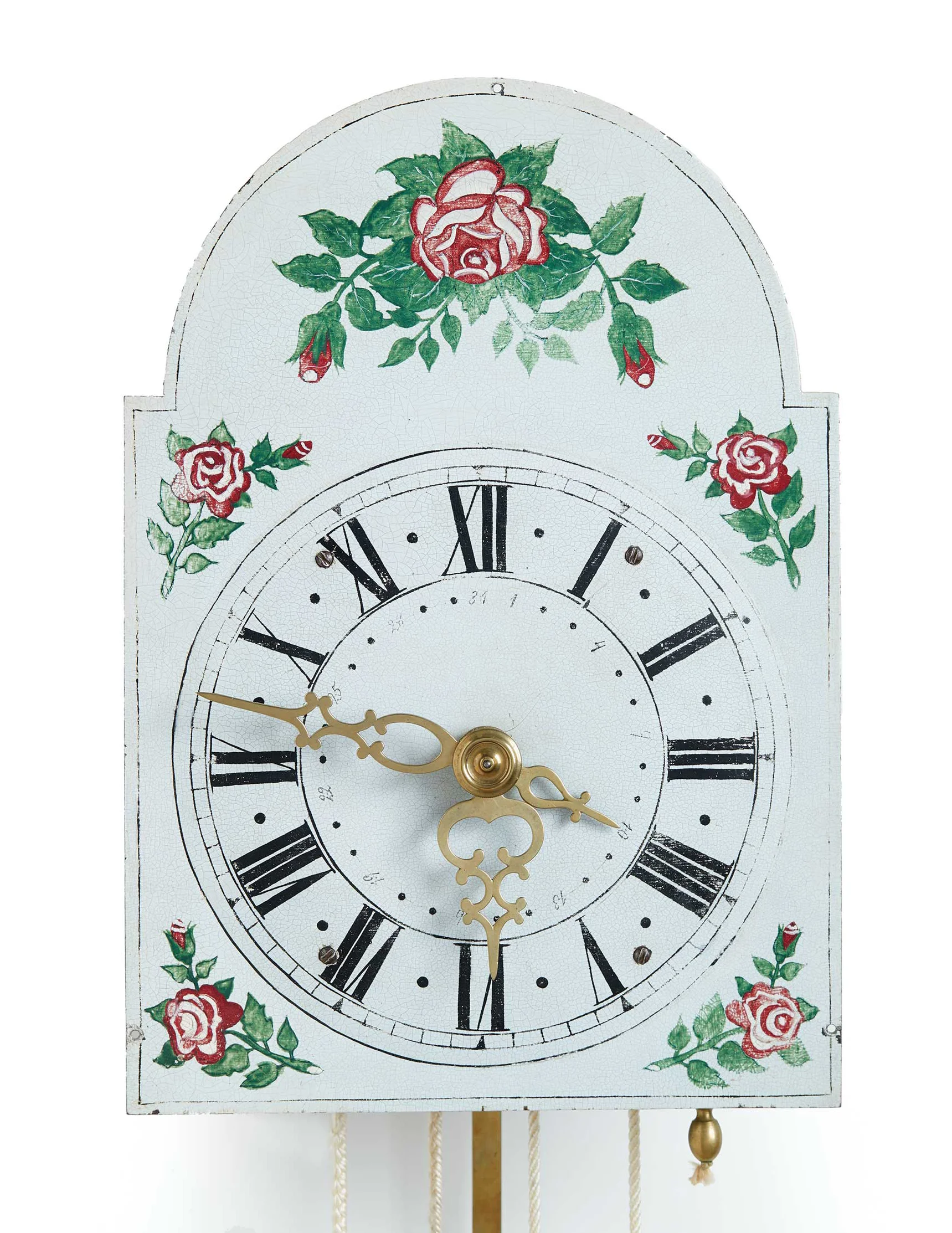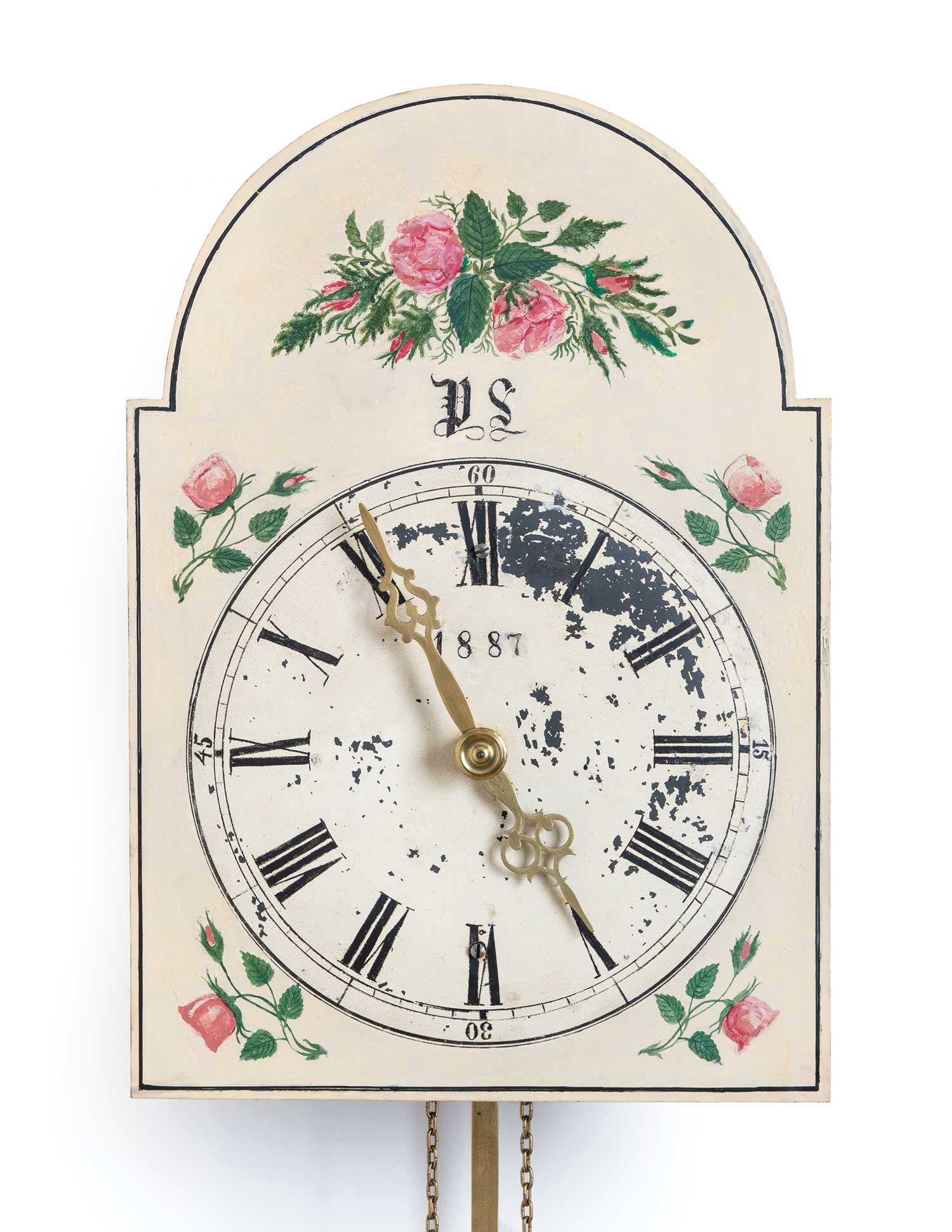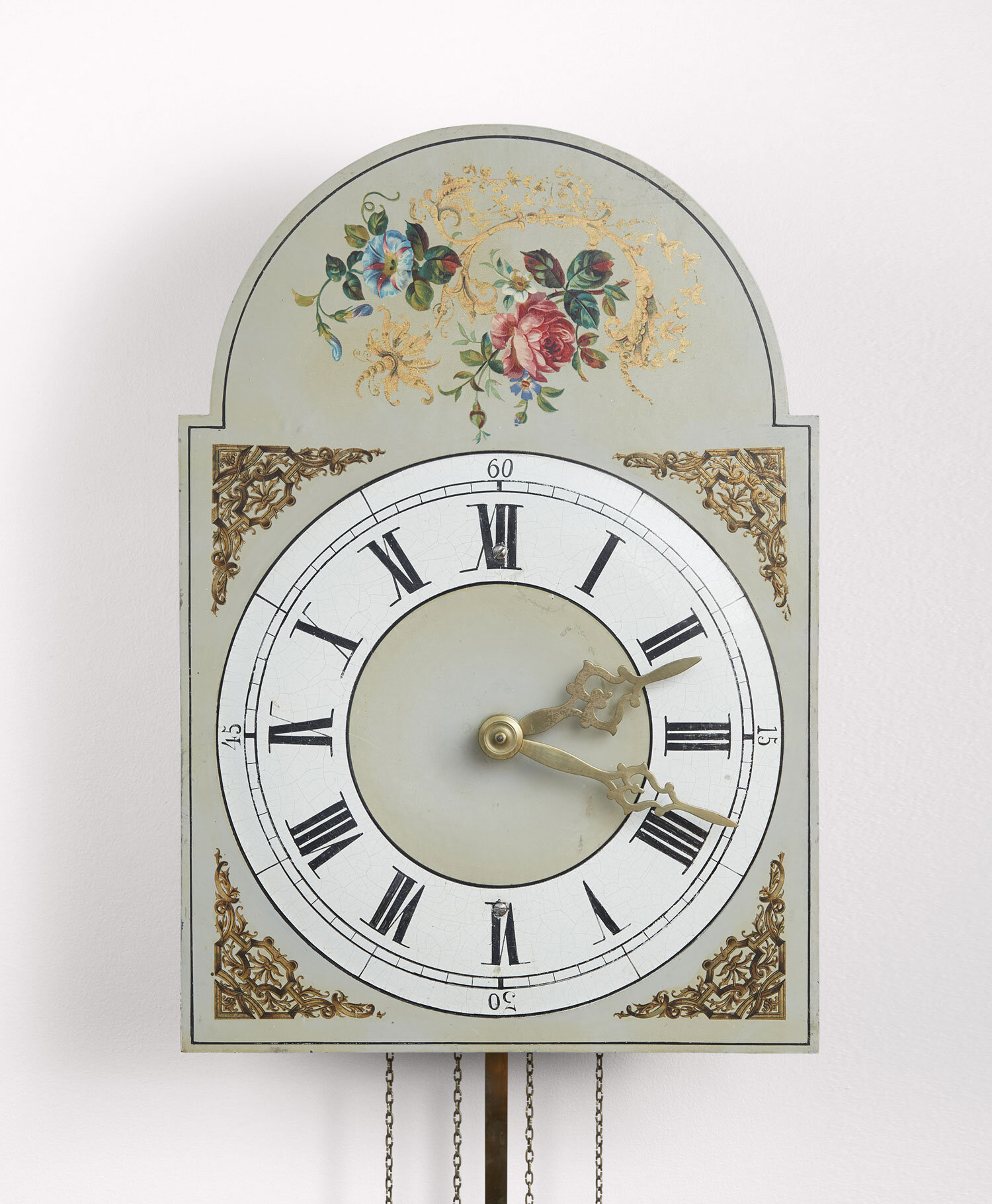Featured Clocks
This first series in our virtual collection of historical clocks features nearly two centuries of artistic and technical achievements by Mennonite clockmakers. The history of each clock has been drawn from material meticulously collected and assembled by the late Arthur Kroeger as well as histories supplied by current clock owners.
Photographs that include details of the clock interiors illustrate the fine inner workings of these treasured heirlooms.
This clock’s round dial and simple, rope-driven movement originated in Prussia in the eighteenth century.
The Mandtlers, like the Kroegers, had a clockmaking tradition going back to the eighteenth century.
Hildebrand Clock no. 334, 1871 (MC0223)
Made only a year after Mandtler clock MC0220, this clock tells the minute, chimes the hour, and tracks the date.
Hamm Clock, 1852 (MC0258)
Gerhard Hamm marked the hour wheels of his clocks, including this one, with his initials and the year they were made.
Kroeger Clock no. 1689, 1893 (MC0002)
Though not an unusual design, this is not a typical one; most Kroeger clocks of this period had lighter dials with floral decals.
This clock has the hallmarks of later Kroeger clocks: the movement is more modern, it uses a chain drive instead of the more traditional rope drive, and the dished-out chapter ring, which enabled the dial to be thinner, was now standard.
The second Gerhard Mandtler (1855–1930) built his own factory in Lindenau, which was held in much the same esteem as the Kroeger factory at the beginning of the twentieth century.
This thirty-hour wall clock was made by the Kroeger Clockmakers in Rosenthal, Russian Empire (now Ukraine), ca. 1910 with serial number 5883 stamped on the brass frame.
Henry Hildebrand, former owner of this clock, came from the village of Ebenberg, Yakovlevo settlement, in what is now Ukraine'.
The Paraguay Clock’s origins lie in two clocks. The dial of the Paraguay Clock was originally attached to the movement of the ‘Rosenthal Clock’, MC0008.
The face was originally decorated with a winter scene but when the paint started to peel, the owners had the face repainted with a Ukrainian dancing scene.
Daniel Teichroew settled in Edenburg, Manitoba, Canada (near Gretna). Early in the 1920s the clock was given to missionary Peter William Penner (1876–1953), who took it to India.
Johann J. (1877–1935) and Anna (Funk) Wieler (1878–1967) received this clock as a wedding gift upon their marriage in 1898.
The original two small weights from this clock were misplaced, but Arthur Kroeger brought two replicas, which he made specifically for the museum where the clock resides.
‘Black and White Werder’ Clock
This clock was made in the Werder style in 1798, possibly by Peter Kroeger, a brother to Johann Kroeger (1754–1823).
This clock was repainted in Canada, possibly by the same person who repainted the Buhr-Regier Clock, MC0137.
This clock was made sometime in the mid-eighteenth century in Prussia (in the Vistula Delta region, present-day Poland).
This thirty-hour wall clock was made by Abraham Kroeger (1791–1872) in Rosenthal, Russian Empire (now Ukraine), ca. 1835.
This clock was made by Peter Lepp (1817–1871), who learned clockmaking from his Janzen relatives in Prussia (in the Vistula Delta region, present-day Poland).
This clock was likely presented to Gerhard and Agatha (Harms) Reimer upon their marriage in 1923.
Arthur Kroeger gifted this clock to the current owner in appreciation for being his apprentice.
The clock was a gift for Abram Koop (1863–1938) and Katherina Niebuhr (1869–1962) on the occasion of their wedding in 1886. The clock is now 130 years old.
This clock is an example of a very common design in later Kroeger clocks–flowers surrounded by a gold scroll.
The original owner of this clock was Jacob Wiebe of Neuendorf, Chortitza Colony, Russian Empire (now Ukraine).
Kroeger Clock no. 5688, ca. 1910 (MC0210)
This clock was made by the Kroeger Clockmakers in Rosenthal, Russian Empire (now Ukraine), ca. 1910.
The recent owner confirmed that this clock was made by Kornelius Hildebrand (1833–1920).
The owner's grandfather, Julius G. Toews, bought this clock in 1923 from a Russian immigrant.
The scratches on the clock were made by soldiers with swords and date to the time of the Russian Revolution, 1918 to 1921.
This Kroeger clock was given to Peter Jacob Reimer and Aganetha Reimer from Kronstal-Osterwick, South Russia (present day Ukraine), in 1910.
This clock was found in the hayloft of the barn belonging to David Rempel. David 'rescued' the clock from the hayloft and brought it home to Winnipeg.
Maria Foth (1918–2014), brought this clock to Canada from Russia. She later wrote a book detailing her experiences during the Second World War and her immigration to Canada.
This clock was restored and repainted in 2002. The owner recalls that the clock looked 'very similar' after its restoration to its appearance when her grandparents owned it.
This Kroeger clock was originally owned by the late Johann Froese (great-grandson of Johann Bartsch) and his wife Anna.
This clock likely moved from Canada to Russia in the 1870s and then to Chihuahua, Mexico around the 1920s.
The couple that first owned this clock lived in Heuboden, in the Bergthal Colony, Russian Empire (now Ukraine) and were married in 1844.
The owner of this clock and his sisters fled from Alexanderkrone, Molotchna Colony, during the Great Trek out of the Soviet Union between 1943 and 1945 carrying this clock with them.
This clocks was possibly made by a Mandtler clockmaker in Lindenau, Russian Empire (now Ukraine), in 1860.
This clocks was probably made by David Kroeger (1829–1909) in Rosenthal, Russian Empire (now Ukraine), in 1869.
This clock originally belonged to a widow named Mrs. Unrau. In November 1926, she and her children boarded the SS Metagama, seeking a better life in Canada
This clocks was made by the Kroeger Clockmakers in Rosenthal, Russian Empire (now Ukraine), ca. 1910, serial number 4512.
Peter Lepp made this clock in 1837 in his workshop in Chortitza, Russian Empire (now Ukraine). This clock has been passed down through the Falk family as long as can be remembered.







































